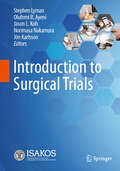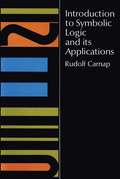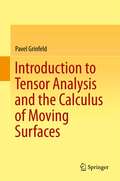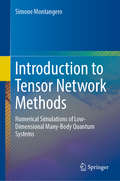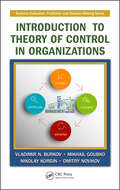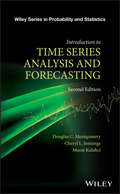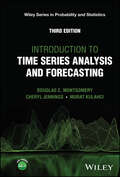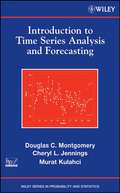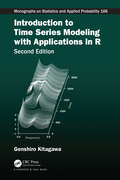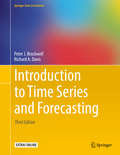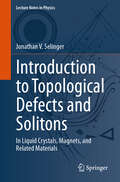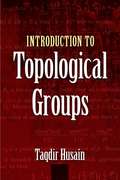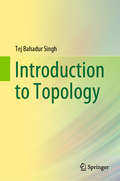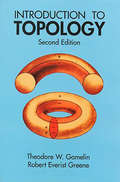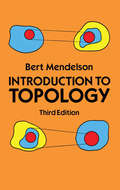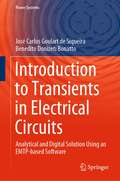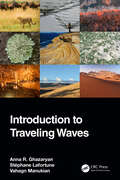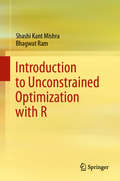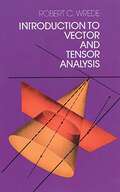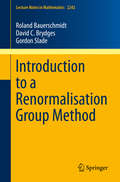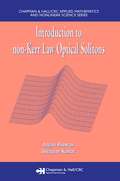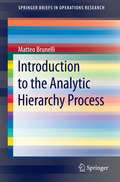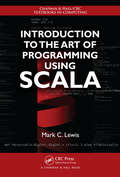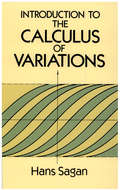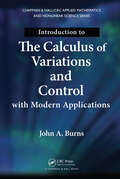- Table View
- List View
Introduction to Surgical Trials
by Norimasa Nakamura Olufemi R. Ayeni Jón Karlsson Jason L. Koh Stephen LymanFilling a gap in literature, this book examines surgical trials with a special focus on the underlying principles, challenges, and best practices to successfully conduct rigorous surgical research.While randomized controlled trials (RCTs) remain the gold standard for evaluation of the safety and efficacy of most medical interventions, they are particularly difficult to implement successfully in the context of surgery. As a result, recruitment rates are often extremely low, crossover from non-operative to operative is common, and patients randomly allocated to surgery often simply decline to have the procedure. All of these challenges call into question the recent generalizability and fundamental quality of traditional surgical RCTs. As such, this book explores advanced alternative trial design methods and describes the current regulatory environment around the world. Designed as a practical guide, it is a valuable tool for surgeons, epidemiologist and biostatisticians involved in this challenging field.
Introduction to Symbolic Logic and Its Applications
by Rudolf CarnapA clear, comprehensive, and rigorous treatment develops the subject from elementary concepts to the construction and analysis of relatively complex logical languages. It then considers the application of symbolic logic to the clarification and axiomatization of theories in mathematics, physics, and biology. Hundreds of problems, examples, and exercises. 1958 edition.
Introduction to Tensor Analysis and the Calculus of Moving Surfaces
by Pavel GrinfeldThis textbook is distinguished from other texts on the subject by the depth of the presentation and the discussion of the calculus of moving surfaces, which is an extension of tensor calculus to deforming manifolds. Designed for advanced undergraduate and graduate students, this text invites its audience to take a fresh look at previously learned material through the prism of tensor calculus. Once the framework is mastered, the student is introduced to new material which includes differential geometry on manifolds, shape optimization, boundary perturbation and dynamic fluid film equations. The language of tensors, originally championed by Einstein, is as fundamental as the languages of calculus and linear algebra and is one that every technical scientist ought to speak. The tensor technique, invented at the turn of the 20th century, is now considered classical. Yet, as the author shows, it remains remarkably vital and relevant. The author's skilled lecturing capabilities are evident by the inclusion of insightful examples and a plethora of exercises. A great deal of material is devoted to the geometric fundamentals, the mechanics of change of variables, the proper use of the tensor notation and the discussion of the interplay between algebra and geometry. The early chapters have many words and few equations. The definition of a tensor comes only in Chapter 6 - when the reader is ready for it. While this text maintains a consistent level of rigor, it takes great care to avoid formalizing the subject. The last part of the textbook is devoted to the Calculus of Moving Surfaces. It is the first textbook exposition of this important technique and is one of the gems of this text. A number of exciting applications of the calculus are presented including shape optimization, boundary perturbation of boundary value problems and dynamic fluid film equations developed by the author in recent years. Furthermore, the moving surfaces framework is used to offer new derivations of classical results such as the geodesic equation and the celebrated Gauss-Bonnet theorem.
Introduction to Tensor Network Methods: Numerical simulations of low-dimensional many-body quantum systems
by Simone MontangeroThis volume of lecture notes briefly introduces the basic concepts needed in any computational physics course: software and hardware, programming skills, linear algebra, and differential calculus. It then presents more advanced numerical methods to tackle the quantum many-body problem: it reviews the numerical renormalization group and then focuses on tensor network methods, from basic concepts to gauge invariant ones. Finally, in the last part, the author presents some applications of tensor network methods to equilibrium and out-of-equilibrium correlated quantum matter.The book can be used for a graduate computational physics course. After successfully completing such a course, a student should be able to write a tensor network program and can begin to explore the physics of many-body quantum systems. The book can also serve as a reference for researchers working or starting out in the field.
Introduction to Theory of Control in Organizations (Systems Evaluation, Prediction, and Decision-Making)
by Vladimir N. Burkov Mikhail Goubko Nikolay Korgin Dmitry NovikovIntroduction to Theory of Control in Organizations explains how methodologies from systems analysis and control theory, including game and graph theory, can be applied to improve organizational management. The theory presented extends the traditional approach to management science by introducing the optimization and game-theoretical tools required
Introduction to Time Series Analysis and Forecasting
by Murat Kulahci Douglas C. Montgomery Cheryl L. JenningsPraise for the First Edition "...[t]he book is great for readers who need to apply the methods and models presented but have little background in mathematics and statistics." -MAA Reviews Thoroughly updated throughout, Introduction to Time Series Analysis and Forecasting, Second Edition presents the underlying theories of time series analysis that are needed to analyze time-oriented data and construct real-world short- to medium-term statistical forecasts. Authored by highly-experienced academics and professionals in engineering statistics, the Second Edition features discussions on both popular and modern time series methodologies as well as an introduction to Bayesian methods in forecasting. Introduction to Time Series Analysis and Forecasting, Second Edition also includes: Over 300 exercises from diverse disciplines including health care, environmental studies, engineering, and finance More than 50 programming algorithms using JMP®, SAS®, and R that illustrate the theory and practicality of forecasting techniques in the context of time-oriented data New material on frequency domain and spatial temporal data analysis Expanded coverage of the variogram and spectrum with applications as well as transfer and intervention model functions A supplementary website featuring PowerPoint® slides, data sets, and select solutions to the problems Introduction to Time Series Analysis and Forecasting, Second Edition is an ideal textbook upper-undergraduate and graduate-levels courses in forecasting and time series. The book is also an excellent reference for practitioners and researchers who need to model and analyze time series data to generate forecasts.
Introduction to Time Series Analysis and Forecasting (WILEY SERIES IN PROB & STATISTICS/see 1345/6,6214/5)
by Murat Kulahci Douglas C. Montgomery Cheryl L. JenningsBring the latest statistical tools to bear on predicting future variables and outcomes A huge range of fields rely on forecasts of how certain variables and causal factors will affect future outcomes, from product sales to inflation rates to demographic changes. Time series analysis is the branch of applied statistics which generates forecasts, and its sophisticated use of time oriented data can vastly impact the quality of crucial predictions. The latest computing and statistical methodologies are constantly being sought to refine these predictions and increase the confidence with which important actors can rely on future outcomes. Time Series Analysis and Forecasting presents a comprehensive overview of the methodologies required to produce these forecasts with the aid of time-oriented data sets. The potential applications for these techniques are nearly limitless, and this foundational volume has now been updated to reflect the most advanced tools. The result, more than ever, is an essential introduction to a core area of statistical analysis. Readers of the third edition of Time Series Analysis and Forecasting will also find: Updates incorporating JMP, SAS, and R software, with new examples throughout Over 300 exercises and 50 programming algorithms that balance theory and practice Supplementary materials in the e-book including solutions to many problems, data sets, and brand-new explanatory videos covering the key concepts and examples from each chapter. Time Series Analysis and Forecasting is ideal for graduate and advanced undergraduate courses in the areas of data science and analytics and forecasting and time series analysis. It is also an outstanding reference for practicing data scientists.
Introduction to Time Series Analysis and Forecasting, 2nd Edition
by Murat Kulahci Douglas C. Montgomery Cheryl L. JenningsAn accessible introduction to the most current thinking in and practicality of forecasting techniques in the context of time-oriented data.Analyzing time-oriented data and forecasting are among the most important problems that analysts face across many fields, ranging from finance and economics to production operations and the natural sciences. As a result, there is a widespread need for large groups of people in a variety of fields to understand the basic concepts of time series analysis and forecasting. Introduction to Time Series Analysis and Forecasting presents the time series analysis branch of applied statistics as the underlying methodology for developing practical forecasts, and it also bridges the gap between theory and practice by equipping readers with the tools needed to analyze time-oriented data and construct useful, short- to medium-term, statistically based forecasts.Seven easy-to-follow chapters provide intuitive explanations and in-depth coverage of key forecasting topics, including:Regression-based methods, heuristic smoothing methods, and general time series modelsBasic statistical tools used in analyzing time series dataMetrics for evaluating forecast errors and methods for evaluating and tracking forecasting performance over timeCross-section and time series regression data, least squares and maximum likelihood model fitting, model adequacy checking, prediction intervals, and weighted and generalized least squaresExponential smoothing techniques for time series with polynomial components and seasonal dataForecasting and prediction interval construction with a discussion on transfer function models as well as intervention modeling and analysisMultivariate time series problems, ARCH and GARCH models, and combinations of forecastsThe ARIMA model approach with a discussion on how to identify and fit these models for non-seasonal and seasonal time seriesThe intricate role of computer software in successful time series analysis is acknowledged with the use of Minitab, JMP, and SAS software applications, which illustrate how the methods are imple-mented in practice. An extensive FTP site is available for readers to obtain data sets, Microsoft Office PowerPoint slides, and selected answers to problems in the book. Requiring only a basic working knowledge of statistics and complete with exercises at the end of each chapter as well as examples from a wide array of fields, Introduction to Time Series Analysis and Forecasting is an ideal text for forecasting and time series courses at the advanced undergraduate and beginning graduate levels. The book also serves as an indispensable reference for practitioners in business, economics, engineering, statistics, mathematics, and the social, environmental, and life sciences.
Introduction to Time Series Modeling with Applications in R (Chapman & Hall/CRC Monographs on Statistics and Applied Probability)
by Genshiro KitagawaPraise for the first edition: [This book] reflects the extensive experience and significant contributions of the author to non-linear and non-Gaussian modeling. … [It] is a valuable book, especially with its broad and accessible introduction of models in the state-space framework. –Statistics in Medicine What distinguishes this book from comparable introductory texts is the use of state-space modeling. Along with this come a number of valuable tools for recursive filtering and smoothing, including the Kalman filter, as well as non-Gaussian and sequential Monte Carlo filters. –MAA Reviews Introduction to Time Series Modeling with Applications in R, Second Edition covers numerous stationary and nonstationary time series models and tools for estimating and utilizing them. The goal of this book is to enable readers to build their own models to understand, predict and master time series. The second edition makes it possible for readers to reproduce examples in this book by using the freely available R package TSSS to perform computations for their own real-world time series problems. This book employs the state-space model as a generic tool for time series modeling and presents the Kalman filter, the non-Gaussian filter and the particle filter as convenient tools for recursive estimation for state-space models. Further, it also takes a unified approach based on the entropy maximization principle and employs various methods of parameter estimation and model selection, including the least squares method, the maximum likelihood method, recursive estimation for state-space models and model selection by AIC. Along with the standard stationary time series models, such as the AR and ARMA models, the book also introduces nonstationary time series models such as the locally stationary AR model, the trend model, the seasonal adjustment model, the time-varying coefficient AR model and nonlinear non-Gaussian state-space models. About the Author: Genshiro Kitagawa is a project professor at the University of Tokyo, the former Director-General of the Institute of Statistical Mathematics, and the former President of the Research Organization of Information and Systems.
Introduction to Time Series and Forecasting
by Richard A. Davis Peter J. BrockwellThis book is aimed at the reader who wishes to gain a working knowledge of time series and forecasting methods as applied to economics, engineering and the natural and social sciences. It assumes knowledge only of basic calculus, matrix algebra and elementary statistics. This third edition contains detailed instructions for the use of the professional version of the Windows-based computer package ITSM2000, now available as a free download from the Springer Extras website. The logic and tools of time series model-building are developed in detail. Numerous exercises are included and the software can be used to analyze and forecast data sets of the user''s own choosing. The book can also be used in conjunction with other time series packages such as those included in R. The programs in ITSM2000 however are menu-driven and can be used with minimal investment of time in the computational details. The core of the book covers stationary processes, ARMA and ARIMA processes, multivariate time series and state-space models, with an optional chapter on spectral analysis. Many additional special topics are also covered. New to this edition: A chapter devoted to Financial Time Series Introductions to Brownian motion, Lévy processes and Itô calculus An expanded section on continuous-time ARMA processes Peter J. Brockwell and Richard A. Davis are Fellows of the American Statistical Association and the Institute of Mathematical Statistics and elected members of the International Statistics Institute. Richard A. Davis is the current President of the Institute of Mathematical Statistics and, with W. T. M. Dunsmuir, winner of the Koopmans Prize. Professors Brockwell and Davis are coauthors of the widely used advanced text, Time Series: Theory and Methods, Second Edition (Springer-Verlag, 1991). From reviews of the first edition: This book, like a good science fiction novel, is hard to put down. . . . Fascinating examples hold one''s attention and are taken from an astonishing variety of topics and fields. . . . Given that time series forecasting is really a simple idea, it is amazing how much beautiful mathematics this book encompasses. Each chapter is richly filled with examples that serve to illustrate and reinforce the basic concepts. The exercises at the end of each chapter are well designed and make good use of numerical problems. Combined with the ITSM package, this book is ideal as a textbook for the self-study student or the introductory course student. Overall then, as a text for a university-level course or as a learning aid for an industrial forecaster, I highly recommend the book. --SIAM Review In addition to including ITSM, the book details all of the algorithms used in the package --a quality which sets this text apart from all others at this level. This is an excellent idea for at least two reasons. It gives the practitioner the opportunity to use ITSM more intelligently by providing an extra source of intuition for understanding estimation and forecasting, and it allows the more adventurous practitioners to code their own algorithms for their individual purposes. . . . Overall I find Introduction to Time Series and Forecasting to be a very useful and enlightening introduction to time series. --Journal of the American Statistical Association The emphasis is on hands-on experience and the friendly software that accompanies the book serves the purpose admirably. . . . The authors should be congratulated for making the subject accessible and fun to learn. The book is a pleasure to read and highly recommended. I regard it as the best introductory text in town. --Short Book Reviews, International Statistical Review
Introduction to Topological Defects and Solitons: In Liquid Crystals, Magnets, and Related Materials (Lecture Notes in Physics #1032)
by Jonathan V. SelingerThis textbook introduces topological defects and solitons at a level suitable for advanced undergraduates and beginning graduate students in physics and materials science. It avoids the formal mathematics of topology, and instead concentrates on the physical properties of these topological structures. The first half of the book concentrates on fundamental principles of defects and solitons, and illustrates these principles with a single example—the xy model for 2D magnetic order. It begins by defining the concept of a winding number, and uses this concept to describe the topology of defects (vortices or disclinations) and solitons (domain walls), carefully identifying the similarities and differences between these two types of topological structures. It then goes on to discuss physical properties of defects and solitons, including free energy, dynamics, statistical mechanics, and coupling with curvature. It shows how these concepts emerge from a theory with variable magnitude of order, and hence how topology can be viewed as an approximation to physics. The second half goes on to explore a wider range of topological defects and solitons. First, it considers more complex types of order—2D nematic liquid crystals, 3D magnetic or liquid-crystal order, 2D or 3D crystalline solids—and shows how each type of order leads to specific topological structures. Next, it discusses defects and solitons that are characterized by 2D or 3D measuring surfaces, not just 1D loops, including hedgehogs, skyrmions, and hopfions. These structures are more complex, but they can still be understood using the same fundamental principles. A final chapter describes the formation of phases with regular arrays of defects or solitons.
Introduction to Topological Groups (Dover Books on Mathematics)
by Dr Taqdir HusainSuitable for advanced undergraduates and graduate students in mathematics, this introduction to topological groups presumes familiarity with the elementary concepts of set theory, elements of functional analysis, functions of real and complex variables, and the theory of functions of several variables. Chapters I to V deal with the algebraico-topological aspect of the subject, and Chapters VI to IX emphasize its analytical aspect.After an introductory chapter on the fundamentals of topology and group theory, the treatment explores semitopological groups and the general theory of topological groups. An elementary study of locally compact topological groups is followed by proofs of the open homomorphism and closed graph theorems in a very general setting. Succeeding chapters examine the rudiments of analysis on topological groups. Topics include the Harr measure, finite-dimensional representations of groups, and duality theory and some of its applications. The volume concludes with a chapter that introduces Banach algebras.
Introduction to Topology
by Tej Bahadur SinghTopology is a large subject with several branches, broadly categorized as algebraic topology, point-set topology, and geometric topology. Point-set topology is the main language for a broad range of mathematical disciplines, while algebraic topology offers as a powerful tool for studying problems in geometry and numerous other areas of mathematics. This book presents the basic concepts of topology, including virtually all of the traditional topics in point-set topology, as well as elementary topics in algebraic topology such as fundamental groups and covering spaces. It also discusses topological groups and transformation groups. When combined with a working knowledge of analysis and algebra, this book offers a valuable resource for advanced undergraduate and beginning graduate students of mathematics specializing in algebraic topology and harmonic analysis.
Introduction to Topology: Second Edition (Dover Books on Mathematics)
by Robert Everist Greene Theodore W. GamelinOne of the most important milestones in mathematics in the twentieth century was the development of topology as an independent field of study and the subsequent systematic application of topological ideas to other fields of mathematics.While there are many other works on introductory topology, this volume employs a methodology somewhat different from other texts. Metric space and point-set topology material is treated in the first two chapters; algebraic topological material in the remaining two. The authors lead readers through a number of nontrivial applications of metric space topology to analysis, clearly establishing the relevance of topology to analysis. Second, the treatment of topics from elementary algebraic topology concentrates on results with concrete geometric meaning and presents relatively little algebraic formalism; at the same time, this treatment provides proof of some highly nontrivial results. By presenting homotopy theory without considering homology theory, important applications become immediately evident without the necessity of a large formal program.Prerequisites are familiarity with real numbers and some basic set theory. Carefully chosen exercises are integrated into the text (the authors have provided solutions to selected exercises for the Dover edition), while a list of notations and bibliographical references appear at the end of the book.
Introduction to Topology: Third Edition
by Bert MendelsonHighly regarded for its exceptional clarity, imaginative and instructive exercises, and fine writing style, this concise book offers an ideal introduction to the fundamentals of topology. Originally conceived as a text for a one-semester course, it is directed to undergraduate students whose studies of calculus sequence have included definitions and proofs of theorems. The book's principal aim is to provide a simple, thorough survey of elementary topics in the study of collections of objects, or sets, that possess a mathematical structure.The author begins with an informal discussion of set theory in Chapter 1, reserving coverage of countability for Chapter 5, where it appears in the context of compactness. In the second chapter Professor Mendelson discusses metric spaces, paying particular attention to various distance functions which may be defined on Euclidean n-space and which lead to the ordinary topology. Chapter 3 takes up the concept of topological space, presenting it as a generalization of the concept of a metric space. Chapters 4 and 5 are devoted to a discussion of the two most important topological properties: connectedness and compactness. Throughout the text, Dr. Mendelson, a former Professor of Mathematics at Smith College, has included many challenging and stimulating exercises to help students develop a solid grasp of the material presented.
Introduction to Transients in Electrical Circuits: Analytical and Digital Solution Using an EMTP-based Software (Power Systems)
by Benedito Donizeti Bonatto José Carlos Goulart de SiqueiraThis book integrates analytical and digital solutions through Alternative Transients Program (ATP) software, recognized for its use all over the world in academia and in the electric power industry, utilizing a didactic approach appropriate for graduate students and industry professionals alike.This book presents an approach to solving singular-function differential equations representing the transient and steady-state dynamics of a circuit in a structured manner, and without the need for physical reasoning to set initial conditions to zero plus (0+). It also provides, for each problem presented, the exact analytical solution as well as the corresponding digital solution through a computer program based on the Electromagnetics Transients Program (EMTP).Of interest to undergraduate and graduate students, as well as industry practitioners, this book fills the gap between classic works in the field of electrical circuits and more advanced works in the field of transients in electrical power systems, facilitating a full understanding of digital and analytical modeling and solution of transients in basic circuits.
Introduction to Traveling Waves
by Stéphane Lafortune Anna R. Ghazaryan Vahagn ManukianIntroduction to Traveling Waves is an invitation to research focused on traveling waves for undergraduate and masters level students. Traveling waves are not typically covered in the undergraduate curriculum, and topics related to traveling waves are usually only covered in research papers, except for a few texts designed for students. This book includes techniques that are not covered in those texts. Through their experience involving undergraduate and graduate students in a research topic related to traveling waves, the authors found that the main difficulty is to provide reading materials that contain the background information sufficient to start a research project without an expectation of an extensive list of prerequisites beyond regular undergraduate coursework. This book meets that need and serves as an entry point into research topics about the existence and stability of traveling waves. Features Self-contained, step-by-step introduction to nonlinear waves written assuming minimal prerequisites, such as an undergraduate course on linear algebra and differential equations. Suitable as a textbook for a special topics course, or as supplementary reading for courses on modeling. Contains numerous examples to support the theoretical material. Supplementary MATLAB codes available via GitHub.
Introduction to Unconstrained Optimization with R
by Shashi Kant Mishra Bhagwat RamThis book discusses unconstrained optimization with R—a free, open-source computing environment, which works on several platforms, including Windows, Linux, and macOS. The book highlights methods such as the steepest descent method, Newton method, conjugate direction method, conjugate gradient methods, quasi-Newton methods, rank one correction formula, DFP method, BFGS method and their algorithms, convergence analysis, and proofs. Each method is accompanied by worked examples and R scripts. To help readers apply these methods in real-world situations, the book features a set of exercises at the end of each chapter. Primarily intended for graduate students of applied mathematics, operations research and statistics, it is also useful for students of mathematics, engineering, management, economics, and agriculture.
Introduction to Vector and Tensor Analysis
by Robert C. WredeA broad introductory treatment, this volume examines general Cartesian coordinates, the cross product, Einstein's special theory of relativity, bases in general coordinate systems, maxima and minima of functions of two variables, line integrals, integral theorems, fundamental notions in n-space, Riemannian geometry, algebraic properties of the curvature tensor, and more. 1963 edition.
Introduction to a Renormalisation Group Method (Lecture Notes in Mathematics #2242)
by Roland Bauerschmidt David C. Brydges Gordon SladeThis is a primer on a mathematically rigorous renormalisation group theory, presenting mathematical techniques fundamental to renormalisation group analysis such as Gaussian integration, perturbative renormalisation and the stable manifold theorem. It also provides an overview of fundamental models in statistical mechanics with critical behaviour, including the Ising and φ4 models and the self-avoiding walk. The book begins with critical behaviour and its basic discussion in statistical mechanics models, and subsequently explores perturbative and non-perturbative analysis in the renormalisation group. Lastly it discusses the relation of these topics to the self-avoiding walk and supersymmetry. Including exercises in each chapter to help readers deepen their understanding, it is a valuable resource for mathematicians and mathematical physicists wanting to learn renormalisation group theory.
Introduction to non-Kerr Law Optical Solitons
by Anjan Biswas Swapan KonarDespite remarkable developments in the field, a detailed treatment of non-Kerr law media has not been published. Introduction to non-Kerr Law Optical Solitons is the first book devoted exclusively to optical soliton propagation in media that possesses non-Kerr law nonlinearities.After an introduction to the basic features of fiber-optic com
Introduction to the Analytic Hierarchy Process
by Matteo BrunelliThe Analytic Hierarchy Process (AHP) has been one of the foremost mathematical methods for decision making with multiple criteria and has been widely studied in the operations research literature as well as applied to solve countless real-world problems. This book is meant to introduce and strengthen the readers' knowledge of the AHP, no matter how familiar they may be with the topic. This book provides a concise, yet self-contained, introduction to the AHP that uses a novel and more pedagogical approach. It begins with an introduction to the principles of the AHP, covering the critical points of the method, as well as some of its applications. Next, the book explores further aspects of the method, including the derivation of the priority vector, the estimation of inconsistency, and the use of AHP for group decisions. Each of these is introduced by relaxing initial assumptions. Furthermore, this booklet covers extensions of AHP, which are typically neglected in elementary expositions of the methods. Such extensions concern different numerical representations of preferences and the interval and fuzzy representations of preferences to account for uncertainty. During the whole exposition, an eye is kept on the most recent developments of the method.
Introduction to the Art of Programming Using Scala (Chapman And Hall/crc Textbooks In Computing Ser.)
by Mark C. LewisWith its flexibility for programming both small and large projects, Scala is an ideal language for teaching beginning programming. Yet there are no textbooks on Scala currently available for the CS1/CS2 levels. Introduction to the Art of Programming Using Scala presents many concepts from CS1 and CS2 using a modern, JVM-based language that works we
Introduction to the Calculus of Variations
by Hans SaganExcellent text provides basis for thorough understanding of the problems, methods and techniques of the calculus of variations and prepares readers for the study of modern optimal control theory. Treatment limited to extensive coverage of single integral problems in one and more unknown functions. Carefully chosen variational problems and over 400 exercises. "Should find wide acceptance as a text and reference."--American Mathematical Monthly. 1969 edition. Bibliography.
Introduction to the Calculus of Variations and Control with Modern Applications
by John A. BurnsIntroduction to the Calculus of Variations and Control with Modern Applications provides the fundamental background required to develop rigorous necessary conditions that are the starting points for theoretical and numerical approaches to modern variational calculus and control problems. The book also presents some classical sufficient conditions a
